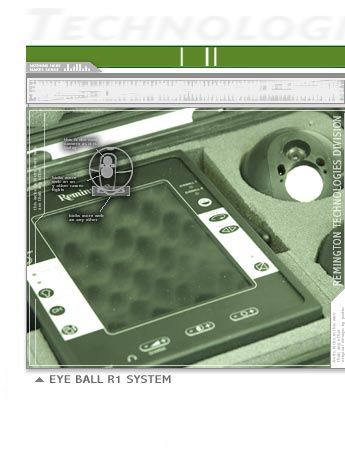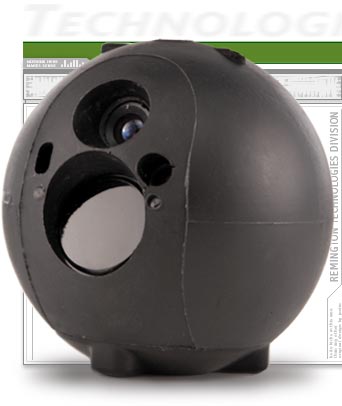Criminals, insurgents, and terrorists beware. The Eye Ball R1 remote-controlled 360-degree spherical camera system, or "mobile display system", originally designed and developed by O.D.F. Optronics, Ltd., out of Tel-Aviv, Israel, will now be manufactured and marketed in the U.S. by Remington Technologies, a division of Remington Arms Company, Ltd., through a licensing agreement.  The EyeBall R1’s omni-directional camera can rotate at 4 rpm until a target is identified, and then give the operator a 55-degree horizontal and 41-degree vertical field of view, as well as near-infrared (IR) spectrum night vision capability for low-light deployment/night operations. You can stick the Eye Ball R1 on a mobile robot, remote-viewing, pole, or any other relevant tactical device, even a remote-control car (which has apparently already been done). Once the device is tossed/thrown, it remains static after landing. Only the camera rotates. If the Eye Ball R1 lands upside down, the operator can flip the video feed in order to view things right-side-up. By the way, it’s been reported that the EyeBall R1 can survive a two-story drop.
The EyeBall R1’s omni-directional camera can rotate at 4 rpm until a target is identified, and then give the operator a 55-degree horizontal and 41-degree vertical field of view, as well as near-infrared (IR) spectrum night vision capability for low-light deployment/night operations. You can stick the Eye Ball R1 on a mobile robot, remote-viewing, pole, or any other relevant tactical device, even a remote-control car (which has apparently already been done). Once the device is tossed/thrown, it remains static after landing. Only the camera rotates. If the Eye Ball R1 lands upside down, the operator can flip the video feed in order to view things right-side-up. By the way, it’s been reported that the EyeBall R1 can survive a two-story drop.  Defense Review has actually been following the technology for awhile now, ever since O.D.F. Optronics Ltd. first released information about it. We just never quite got around to writing about it. O.D.F. Optronics is a research and development firm that specializes in "vision-based products for defense and security applications". Co-founded by two computer-vision engineers named Ehud Gal and Natan Merom, O.D.F Optronics designs, develops, and markets electro-optic systems, omni-directional imaging systems, omni-directional optics, and image processing and image understanding software. Development of the Eye Ball R1 was handled by O.D.F. Optronics’ defense division.
Defense Review has actually been following the technology for awhile now, ever since O.D.F. Optronics Ltd. first released information about it. We just never quite got around to writing about it. O.D.F. Optronics is a research and development firm that specializes in "vision-based products for defense and security applications". Co-founded by two computer-vision engineers named Ehud Gal and Natan Merom, O.D.F Optronics designs, develops, and markets electro-optic systems, omni-directional imaging systems, omni-directional optics, and image processing and image understanding software. Development of the Eye Ball R1 was handled by O.D.F. Optronics’ defense division.
Compact, lightweight, and ruggedized, the EyeBall R1 was designed and developed to be deployed/employed for…
 military Special Operations (SPECOPS), law enforcement SWAT/SRT operations, anti-terrorism/counterterrorism operations, hostage rescue operations, and just about any and all other types of tactical operations for which a small, rugged, lightweight wireless audio device/video camera can come in handy. According to the company, potential applications for the technology include (but are not limited to) Dynamic Entry/High-Risk Entry Operations (including room clearing and stairwell clearing), ceiling and attic Investigation, surveillance operations, and search and rescue operations.
military Special Operations (SPECOPS), law enforcement SWAT/SRT operations, anti-terrorism/counterterrorism operations, hostage rescue operations, and just about any and all other types of tactical operations for which a small, rugged, lightweight wireless audio device/video camera can come in handy. According to the company, potential applications for the technology include (but are not limited to) Dynamic Entry/High-Risk Entry Operations (including room clearing and stairwell clearing), ceiling and attic Investigation, surveillance operations, and search and rescue operations.
Due to its ruggedized construction, the Remington Technologies Eye Ball R1 can be rolled, tossed, or thrown wherever necessary. Once deployed, the system can capture video out to 25 yards away and audio up to a distance of 5 yards, and then broadcast both up to 200 yards wirelessly back to a large remote control device called a Personal Display Unit (PDU), operated by the tactical operator. The PDU can communicate with two Eye Ball R1’s simultaneously. The PDU’s color video screen is 6.4".
 The EyeBall R1’s omni-directional camera can rotate at 4 rpm until a target is identified, and then give the operator a 55-degree horizontal and 41-degree vertical field of view, as well as near-infrared (IR) spectrum night vision capability for low-light deployment/night operations. You can stick the Eye Ball R1 on a mobile robot, remote-viewing, pole, or any other relevant tactical device, even a remote-control car (which has apparently already been done). Once the device is tossed/thrown, it remains static after landing. Only the camera rotates. If the Eye Ball R1 lands upside down, the operator can flip the video feed in order to view things right-side-up. By the way, it’s been reported that the EyeBall R1 can survive a two-story drop.
The EyeBall R1’s omni-directional camera can rotate at 4 rpm until a target is identified, and then give the operator a 55-degree horizontal and 41-degree vertical field of view, as well as near-infrared (IR) spectrum night vision capability for low-light deployment/night operations. You can stick the Eye Ball R1 on a mobile robot, remote-viewing, pole, or any other relevant tactical device, even a remote-control car (which has apparently already been done). Once the device is tossed/thrown, it remains static after landing. Only the camera rotates. If the Eye Ball R1 lands upside down, the operator can flip the video feed in order to view things right-side-up. By the way, it’s been reported that the EyeBall R1 can survive a two-story drop. DefenseReview finds the Eye Ball R1 technology interesting. To be honest, we always enjoy tactically-relevant telepresence technology, here at DefRev. The overall package here looks pretty slick. What can we say, the Israelis keep coming up with new and innovative tactical technologies. Frankly, we like any technology that can potentially enable military SPECOPS, LE SWAT, and anti-terrorism/counterterrorism operators to perform their missions more safely, effectively, and efficiently. It would appear that the Eye Ball R1 can do that, but we’ll just have to wait and see.
For military Special Operations and anti-terrorism/counterterrorism operations, it would be interesting to see if it would be possible to create a specialized version of EyeBall R1 outfitted internally with plastic explosives (like C4, for instance) and concentrically-arranged ball bearings, so operators can remotely detonate it, and thus remotely terminate the hostile threat(s) immediately, right then and there, once the target(s) is/are located and identified. This could only be done if capture and interrogation are unnecessary for gathering intel and the team is either sure that no non-targeted personnel are present, or collateral damage is deemed acceptable. Think of it as a smart grenade (defensive grenade). Deploy, locate, identify, detonate. It’s that easy. Sure, it’ll be a little larger and heavier in weight, and a good bit more costly than a standard fragmention grenade (defensive grenade). However, as long as it’s well-balanced (for accurate throwing) and the target(s) is/are important enough, who cares? Of course, it would be much less expensive to just throw in one or two standard frag grenades or flood the room (CQB engagement) after you’ve identified the target(s) with a standard-version Eye Ball R1, but this method would take extra time and increase the chances of the target(s) escaping or responding with force (due to the extra time involved), putting the team and the public at large at greater risk. If you wanna’ go less-lethal, just make a specialized flash-bang (pyrotechnic) version of the EyeBall R1, so you can stun ’em before you flood the room. Actually, the latter is probably much easier said than done. For that, you’d have to make all of the Eye Ball R1’s components rugged enough to handle the pyrotechnic blast, in order to be reusable. This might not be possible.
 Defense Review has actually been following the technology for awhile now, ever since O.D.F. Optronics Ltd. first released information about it. We just never quite got around to writing about it. O.D.F. Optronics is a research and development firm that specializes in "vision-based products for defense and security applications". Co-founded by two computer-vision engineers named Ehud Gal and Natan Merom, O.D.F Optronics designs, develops, and markets electro-optic systems, omni-directional imaging systems, omni-directional optics, and image processing and image understanding software. Development of the Eye Ball R1 was handled by O.D.F. Optronics’ defense division.
Defense Review has actually been following the technology for awhile now, ever since O.D.F. Optronics Ltd. first released information about it. We just never quite got around to writing about it. O.D.F. Optronics is a research and development firm that specializes in "vision-based products for defense and security applications". Co-founded by two computer-vision engineers named Ehud Gal and Natan Merom, O.D.F Optronics designs, develops, and markets electro-optic systems, omni-directional imaging systems, omni-directional optics, and image processing and image understanding software. Development of the Eye Ball R1 was handled by O.D.F. Optronics’ defense division. A few more specs:
The Eye Ball R1 transmits audio and video at 2.4 GHz. The control unit transmits at 902-928 MHz. The Eye Ball R1 is battery powered, and can operate for 2 hours. The PDU can operate for 3 hours.
The Eye Ball R1 transmits audio and video at 2.4 GHz. The control unit transmits at 902-928 MHz. The Eye Ball R1 is battery powered, and can operate for 2 hours. The PDU can operate for 3 hours.